
Vol. 1, No. 9 Published by India China Division, Air Transport Command March 15, 1945
|
Shots To Save Arms
3-in-1 Method of Injecting Serum
is Perfected at 1328
1328 BU, Assam - Combined immunization, the process of giving several serums in one hypodermic shot, has been perfected at this ICD base by its far-sighted base surgeon, Maj. Frank B. Waldorf, Syracuse, N.Y.
Instead of the old way of giving individual hypodermics for typhus, cholera and typhoid, the surgeon combines one cc. each of typhus and cholera with one-half cc. of typhoid serum and gives it all in one dose.
Doc a Guinea Pig
This revolutionary idea of administering three shots in one was born when Maj. Waldoerf noticed in a medical journal an article concerning the mixing of diphtheria and tetanus antitoxins in an experiment.
The surgeon did not use his men as guinea pigs, but instead experimented on himself. He prepared a combination and examined it in a test tube for precipitation or change of any type. There was none. Then he gave a dose to himself and his assistant, Capt. Claude L. Houck, Lewiston, Va., who volunteered, and there was no unfavorable reaction. Next were four medical enlisted men who stepped forward for a try, eager to contribute to this pioneering project. It was likewise successful with them.
Saves Time
In the ordnance section, 100 men were glad to give the one-needle system a try, and from this large group an accurate observation and record could be made. It was popular in every case. Less reaction sickness was an outstanding result. Last came the entire field personnel, after which the combined immunization system was officially called a success.
Much time is saved, because one medical attendant instead of three is required. The plan also reduces to one-third the number of needles, syringes and other supplies used. More accurately measured doses result because large amounts of combined serum are prepared, eliminating the possibility of human error to a greater degree.
Maj. Waldorf said he had never seen or heard of any official Army reports on the use of this method, but a recent rumor drifted in to the effect that another medical section in a different theater was employing it.
Truck Farming To Be Started At Every Base
Gardens To Provide Messes With Vegetables All Year
Hq., Calcutta - What is perhaps the biggest overall gardening project in the ATC has been initiated, and fresh vegetables should line the shelves of every GI mess in the division within a few months.
Under the direction of 1st Lt. F. D. Irving, division agricultural officer, the project will involve selection of sites for gardens at every ICD base.
All COs have appointed an officer and an enlisted man to run the GI farms. The officer will supervise proceedings and the GI will be head wallah over local laborers who are to clear the plots and till the soil.
Seeds Selected
Choice of virgin soil plots, which will be cleared of their natural vegetation, should obviate the use of fertilizer. These gardens, ranging up to 12-acre plots, are expected to supplement QM rations and improve the quality of food.
Seeds have been selected carefully with a view toward obtaining plants that will thrive in the varied climates of three countries. In all, 13 varieties of vegetables will be grown - among them - tomatoes, lettuce, celery, radishes and watermelons.
Plans call for irrigation systems to keep the truck farms producing through the year. Farm tools and machinery will be procured through SOS when possible and the remainder will be bought from local markets. Seeds are being requisitioned from QM.
CG's Idea
The idea of truck farming was fostered by Brig. Gen. Tunner himself, while he tilled a tiny table of land in his backyard. Promoted by Lt. Col. John O. Briggs, assistant division supply and service officer, the division-wide scheme soon came into being.
The chief agriculturalist, Lt. Irving, feels at home in his farming activities. before coming into the Army he worked with the Federal Farm Security program and managed to find time to supervise and run his own James River farm in Virginia.
Lt. Irving has it in mind to grow flowers also, to brighten mess halls and sick bays.
Organize Safety Council To Lower Accident Rate
1330 BU, Assam - A flying safety council comprised of first line experienced pilots, has been organized by Col. William S. Barksdale, Jr., Randolph, Va., CO here, who has set up this pioneering plan to cut the accident rate.
Believed to be the first such council in the Air Forces, it is not to be confused with an accident investigation board. Chairman of the committee is Lt. Benjamin D. Johnston, Fort Smith, Ark., who is also the flying safety officer.
Meets Weekly
The group is composed of ten first pilots picked because of long experience, training in different branches of transport flying in the States and speedy, efficient action during emergencies.
Meetings are held once a week, and because of the comparatively large number of members a quorum of four or five is easily assembled without interfering with regular flying duties. Most of these are straight duty pilots with no additional assignments, and therefore represent the important point of view of the "working man."
Recommendations
Principal objective is to combine ideas and observations to make flying safer. As a result of their work, which began in the first week of January, they made the following recommendations, most of which have been carried out:
1. Co-pilots have difficulty in reading instruments in front of the pilot. Therefore the planes are being modified to carry two sets of instruments.
2. The armor-plated cowl on the C-109 engines added a great deal of excess weight. This has been removed and a light C-87 cowl substituted.
3. Fluorescent lighting proved to be inadequate so the lighting system was changed to provide a light mounted on each control column focused on the instrument panel.
4. Engines accidentally turned off in flight by fliers brushing against switches. A metal guard has been placed over the switches to prevent this.
5. Fuels shut-off valves are checked before each flight, because of past experience in engines catching fire and stubborn valves being hard to turn, to cut off the gas supply.
6. Much trouble had been encountered in the use of the different fuel control systems in various models of the C-109s. A chart now is placed in each airplane, showing exact method for transferring bulk fuel to the operating tanks when a ship is running low on gas.
7. Co-pilots call off the speed and altitude of ships upon entering the traffic pattern so the pilot may devote his attention to maneuvering the plane.
Double Talk Disconcerts CQ as He Wakes Fliers
1332 BU, Assam - The officers' CQ always has his troubles waking the pilots for flight and he is quite accustomed to a steady steam of abuse when he rouses the Hump-harried crews. But recently "something new has been added."
Having called Lt. E. A. Curry once without success, he tried again. This time, Lt. Curry mumbled, "I was awake the first time but I only have two small pairs."
Next on the "wake-up" list was Lt. T. S. Prescott. "What time is it?" he asked.
"4:15, sir," replied the CQ.
"On both engines?"
The CQ prefers the abuse. It makes more sense and it is easier on the nerves.
Biggest Cargo Plane Is Called 'Stratocruiser'
Boeing's New Cargo Ship Has B-29 Wings, Engines, Tail Assembly
America's biggest land-based cargo plane, the Boeing C-97, currently is undergoing acceptance checks before full-scale manufacture for the ATC is begun.
The C-97, a cargo version of the B-29, already has broken many a record. The giant aerial boxcar, officially dubbed the "Stratocruiser," dashed from Seattle to Washington, D.C. in six hours and three minutes.
The ship has B-29 wings, engines and tail assembly. Its blunt-nose fuselage, however, is 12 feet longer than that of the 99-foot B-29. It has a top speed of 400 mph and a range of more than 3,500 miles.
The 10,000 cubic feet of usable cargo space equals that of two railway boxcars. It will carry two light tanks or 100 fully equipped infantrymen in the pressurized cabin.
As a hint to what is in store for the huge transport, if accepted, officials have revealed that 100 C-97s could transport a whole infantry division to China, or any other war theater for that matter, in 48 hours.
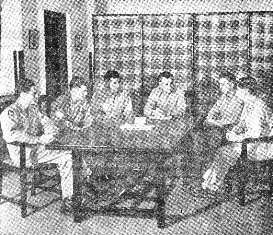 Shortly after the appointment of Maj. John J. Murdock as division flying safety officer, a meeting of FSOs of the
various wings was held in the office of Brig. Gen. Tunner. "ICD accidents due to carelessness and to negligence
must and will cease," said Gen. Tunner in addressing the conference. Left to right are Maj. Harold C. Kirkpatrick,
China wing; Capt. Richard E. Pagett, India wing; Maj. Murdock; Gen. Tunner; Maj. Scott E. Everitt, Assam wing and Capt.
Norman P. Smith, Jr., Bengal wing.
Shortly after the appointment of Maj. John J. Murdock as division flying safety officer, a meeting of FSOs of the
various wings was held in the office of Brig. Gen. Tunner. "ICD accidents due to carelessness and to negligence
must and will cease," said Gen. Tunner in addressing the conference. Left to right are Maj. Harold C. Kirkpatrick,
China wing; Capt. Richard E. Pagett, India wing; Maj. Murdock; Gen. Tunner; Maj. Scott E. Everitt, Assam wing and Capt.
Norman P. Smith, Jr., Bengal wing.
|
Flying Safety Officers
Launch Intensified Drive
An intensive flying safety program has been launched by ICD to counteract the approaching monsoon season, greatly increased traffic over the Hump, and heavier utilization of aircraft.
The first step in the program was a conference with wing flying safety officers held by Maj. John J. Murdock, Jr., newly-appointed division flying safety officer, on March 8 and 9, at Hq., Calcutta.
Maj. Murdock pointed out that while the accident rate per 1,000 hours flown and 1,000 tons of cargo transported over the Hump had fallen in recent months, total number of accidents had risen.
"The tragic thing is that the vast majority are avoidable accidents, the result of personnel error - not the pilots' every time, either." he said.
Man subjects covered by the flying safety officers were training, selection of pilots, briefing and debriefing, pilot discipline, air traffic control, weather, communications, recommendations, prompt action.
Brig. Gen. Tunner informed the officers that every section of the command had been instructed to give 100 percent cooperation to flying safety.
"We are bound to have some accidents in an operation of the magnitude of our," the general said. "But accidents due to carelessness, negligence or ignorance must and will cease. There is no excuse for them."
India-China Flier Sees Heavenly Body As Hump Hazard
1332 BU, Assam - Pilots who were over the Hump on the night of Feb. 23 saw the cockpits of their ships and the sky around them suddenly illuminated with glaring brilliance.
After the pilots landed and told their individual stories, it was decided that a meteor was responsible for the vivid flash of light.
F/O Arthur F. Helin, of this base, perhaps came closer to the falling body than any other pilot. Helin was understandably startled when the brilliance lasted five or more seconds. Further information brought out that a luminous body had streaked through the night, leaving a trail of glowing particles, like a comet's tail.
"Do we now have to contend with flying heavenly bodies along with the other hazards over the Hump?" asked Helin when he learned the truth.
Cargo Glider Towed To Record at 9,000 In Trans-India Hop
Hq., Calcutta - A cargo glider towed by an ICD C-46 and piloted by Lt. Bernard P. McGaulley, of the First Air Commando group, recently flew non-stop from Karachi to a base in eastern India, a distance of 1,650 miles.
The flight is believed to be the longest of its type ever completed. The average altitude was 9,000 feet.
Co-pilot of the glider was Maj. Robert W. Heartwell, of Miami Shores, Fla., ATC technical inspector. Pilots of the ICD tow ship were Capt. Paul J. Slayden and Lt. Lynn Millinger.
A similar flight of 1,320 miles was made in January (HUMP EXPRESS, Jan. 18). Capt. Slayden piloted the tow ship and Maj. Heartwell was one of the glider pilots.

These pictures show the first C-54 flight from the new 1346 BU, activated on Mar. 1. Left: Three attractive Chinese girls came down to the flight line to see the boys off on the first Hump flight. Here Sgt. Ed Crump, Pittsburgh, Pa., (left) smiles his approval and utters a mental "Ding How." Center: The giant C-54 strains at the leash as her four powerful engines are warmed up preparatory to taking off. Right: Lt. Col. Silas A. Morehouse, CO of the new base unit, and Maj. Robert K. Buckle, operations officer, flew the first Hump trip after activation of the base. From the layman's point of view, the maze of instruments, gadgets and buttons is enough proof that it takes more than one man to pilot the huge Skymaster.
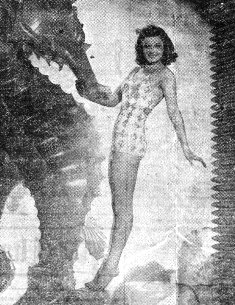 ICD special service wallahs have come to the aid of HUMP EXPRESS's dwindling pin-up file this week, in a munificent
lend-lease gesture. First of the leased lovelies is Esther Williams, starred in MGM's "Bathing Beauty." Nobody tells
us what the overgrown seahorse on the left is up to, which looks like it hopped out of a bottle of Fighter Brand.
ICD special service wallahs have come to the aid of HUMP EXPRESS's dwindling pin-up file this week, in a munificent
lend-lease gesture. First of the leased lovelies is Esther Williams, starred in MGM's "Bathing Beauty." Nobody tells
us what the overgrown seahorse on the left is up to, which looks like it hopped out of a bottle of Fighter Brand.
|
Finds on Trail Things Are Not What They Seem
Search and Rescue Operator Has Narrow Escape In His Jeep
1332 BU, Assam - T/Sgt. Robert J. Meehan, trail man of the Search and Rescue unit (1352) got word that a man requiring hospital care had to be brought in from the jungle.
This seemed just a routine job, on the surface - the kind of job Meehan has been doing for more than a year, using an advanced outpost as his headquarters.
As a matter of fact, this one would be a lot easier than most such jobs, because one of the few passable roads in Burma led almost directly to his destination. This time he could ride in a jeep instead of walking.
Through the Crust
Sgt. Meehan was 35 miles on his way, high up in the hills, when he discovered that things are not always what they seem on the surface, especially roads in Burma.
This road looked all right on top, but recent rains had washed the earth away from the under side of the road, leaving just a shell-like surface. When the front wheel of the jeep hit this, the jeep left the road and plunged down a 75-foot embankment.
Coming to a stop on a shelf 500 feet above the floor of the valley, Sgt. Meehan took stock of the situation. His bearer and guide had a few minor cuts and scratches; he himself had a broken arm.
Taking care of his companions first, he next went about the difficult job of setting his arm in a bamboo splint. Then, with the help of his bearer,
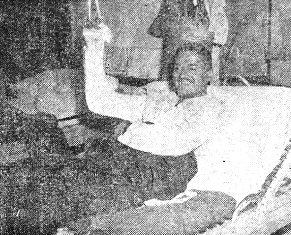 T/Sgt. Robert J. Meehan, search and rescue trail man, has learned his lesson. He'll walk, in Burma, instead of jeeping -
unless the road is guaranteed. He can still smile about it, though.
T/Sgt. Robert J. Meehan, search and rescue trail man, has learned his lesson. He'll walk, in Burma, instead of jeeping -
unless the road is guaranteed. He can still smile about it, though.
|
A runner was sent ahead to the original destination with instruction to have the patient brought out by another route.
Now He Walks
That first night was spent in the Kachin village, where the headman administered rice wine in lieu of GI pain-killing agents. The following morning the long 35-mile walk back through the jungle began. In spite of obvious handicaps, the trip was made in two and a half days.
At a British outpost, Sgt. Meehan had his arm looked at before continuing on. After a wait of several days, the patient reached an ICD base where they were to meet and Meehan finally completed the job of delivering him to a hospital by plane. But what was more, he delivered himself to the detachment of patients as well, which had not been in the cards when he had first started out on the job.
Sgt. Meehan's arm has been set three times already, without anesthetic, and it is due for resetting again. He has learned his lesson, he says. From now on he walks.
Old China Hand Got 4CN Beer
Spent Four Years in Orient with Marine Forces Before War
1340 BU, China - The rotation plan, back in 1928, was as unthought of as being drafted, and the thought of being in any country except the States was something to be associated with adventure.
T/Sgt. George Rice, long before most GIs arrived here, had spent four years in China with the Marines. It was back in the days when "Uncle Joe" Stilwell was a colonel and beer only cost 4CN.
T/Sgt. Rice, of Dallas, Tex., spent nine years with the Marines and served in central China with the expeditionary forces from 1928 to 1932. While in China he was orderly to Gen. Smedley Butler, commanding the international police force at Shanghai. There wasn't much military activity, and life in the Marines was more routine than rugged.
After being discharged in 1936, he settled down to working for Lockheed Aircraft Co., as a member of a flight testing crew.
Rice explained his jump from the Marines to the Army when he enlisted in 1942. He had become so interested in aviation while working for Lockheed that he stated a strong preference for the Air Corps and was assigned to ATC. His present job, which includes a good bit of flying, is section chief of mobile engine change.
Sgt. Rice has received the Air Medal and the Yangtze Service Medal which he earned in the Marines, during the "Shanghai incident."
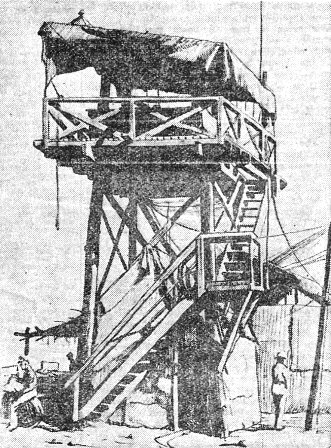 At a field in North Burma, Capt. James P. Scott, ICD artist, made this brush drawing...
At a field in North Burma, Capt. James P. Scott, ICD artist, made this brush drawing...
|
Area Control Regulates Flow Of Hump Goods in Conformity With Needs of Various Bases
In Coordination with Air Traffic Section, It Maintains A Steady Stream
of Supply by Constant Check On Craft, Cargoes, Requirements
1350 BU, Kunming - "Six-two-two calling area control," says the pilot over the Hump. "I am 35 minutes out, and loaded with Y tons of B cargo, manifested for X field."
Area control, in a jam-packed little office in Kunming which is in touch with every Hump-crossing plane, checks the need for cargo B at X field at that moment.
Presently the pilot is called back and told either, "Proceed to X," or "Your manifest is changed. Proceed to field Z."
That's how the area control outfit is keeping cargo flowing to Chinaside bases on a schedule which assures that each field gets, as nearly as possible, what it needs when it needs it.
Area control works hand in hand with the air traffic section, the latter's function being to get the planes to their respective bases safely, while area control's is to regulate cargo routing so as to get supplies to where they are most needed.
Prime aim of area control is the maintenance of cargo flow to individual bases in balanced ratio to the size of the bases, keeping level their stock of 100-octane fuel and meeting demands imposed by tactical situations.
In addition to this purpose (which involves constant adjustments to weather conditions closing a field in at times and dictating a shunt of cargo to another base having similar needs) area control is responsible for safe routing of aircraft in time of enemy action, and for the issuance of navigational instructions to aircraft which lose their way.
Maj. Warren R. Franscioni, of Paso Robles, Calif., handles area control, while air traffic is directed by Capt. Leonard M. Zubko, of Manville, N.J.
Air traffic keeps tabs on a ship from the moment it leaves the ground until it lands. The field from which it departs immediately notifies air traffic, and the fact is noted, after which the pilot is in constant touch with this department.
A small strip of wood marked to indicate his plane is moved along in a grooved holder as he flies, until he reaches his destination, when it is removed from the board and the designation erased.
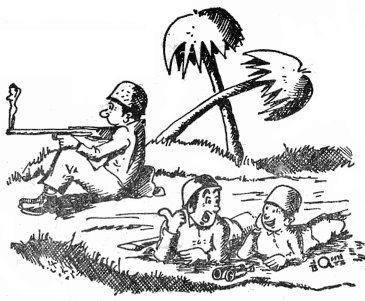
"That new sight of his improves his aim a heck of a lot." - by Cpl. John Boltz, 1345 BU |

It Can Be Done
No one who ever flew it regards the Hump as an "easy" route. At its best, when weather conditions are unusually good, turbulence is almost always present over the Himalaya peaks.
Factors other than weather make the Hump operation difficult. Greatly increased traffic with hundreds of aircraft crossing every 24 hours demand the strictest adherence to traffic control.
Radio interference due to both the terrain and the elements is a customary annoyance which sometimes becomes extremely dangerous, especially when a bearing or position report is badly needed.
Now that the monsoon season is approaching, pilots will have to contend with deluges of rain which some claim to be "thick as a wall," in addition to the gales which normally hurricane through the mountains.
No, Hum flying is not an easy job, even on CAVU days. That is why it is a job for responsible men only, men who know their jobs, know their airplanes and know the Hump and never take an unnecessary risk flying it.
Men who are on their toes, who take every precaution for the safety of their airplane and crew, and who make proper use of every facility afforded them, have no trouble. Hundreds have completed their required missions and gone home.
But men who grow careless, forget to think, or become negligent and just "trust to luck" - well, they usually find themselves in a precarious position, a position from which some don't escape alive.
For the Hump takes a swift and final toll for carelessness, in the air, on the ground, or in the tower. Pilots - the veterans who "licked the Hump" - found early that they couldn't afford to become careless for a single moment.
The same is true all down the line. If a mechanic, a servicing man, an operations officer, or a briefing clerk, slips up of gets a little careless, the result is the same: "One airplane missing - crew unaccounted for."
ICD is plagued with too many preventable accidents caused by the costly mistakes of irresponsible men who, because they forget, hurry, or neglect their jobs, send an airplane and its crew out to disaster.
The real tragedy is that such crashes, with their frightful toll of death, injuries and destruction, are totally unnecessary since they can be prevented.
The Hump can be flown - safely. By using our heads, all of us can succeed at a difficult job. Hundreds of pilots already have proved that it can be done - and safely.
Aid to China
Around the world, ATC means Air Transport Command.
It means the outfit that flies your mail, takes you were you're supposed to go, billets you, feeds you, runs your PX, entertains you and generally conducts your tour.
In ICD, it means all these things, and more, but above all it means "Aid to China." From 1942 until the opening of the Stilwell Road, the air lanes were the only high road to China. Everything that went in - from guns and munitions to road-building machinery and personnel - had to be flown, and of course, ICD had the bulk of the job.
Today, even though The Road is open, monthly lift to China still must be increased, for China needs every possible ounce of supplies she can get, to fight the Jap.
Nor is ICD's part limited to merely flying the Hump, for today this command's aircraft based in China move troops, munitions and other battle necessities on short notice to any point the tactical situation dictates.
So ATC means "Aid to China" here, aid which official sources in Washington estimate will reach 500,000 tons this year. Contrast that to the 231,000 tons moved in 1944, and the 48,500 tons moved in 1943!
When this far eastern war finally is won, the part that ATC has played in supplying China will go down in military history.
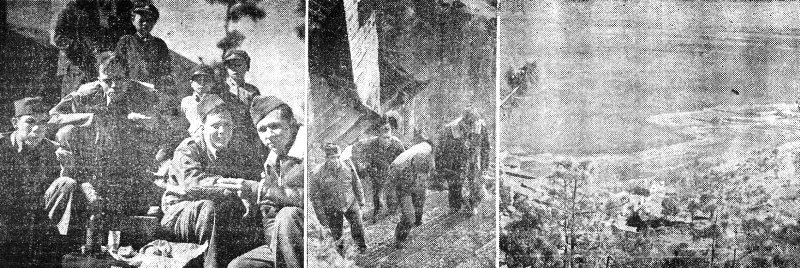
(1) Four GIs fortify themselves for the West mountain ascent. With many a "ding-how," little Chinese kibitzers express their approval of the chow and patiently await leftovers. (2) Thousands of shallow steps lead to the topmost shrine of the Buddhists, and the climbers must abandon their weapons-carrier and complete the ascent by foot. (3) From the dizzy heights of "Old Baldy" the pilgrims gain an unexcelled view of the countryside and the lake.
Sacred Shih Shan Temples Are Maze of Idols, Statues
By Cpl. Gil Saudade Photos by Cpl. Len Strauss
Shih Shan, or West Mountain, guarding the approaches to ICD's largest base in China, is about 15 miles from Kunming. Nicknamed by irreverent GIs "Old Baldy," it is a sacred old mountain to the Chinese, and has been since about 100 A.D., when Buddhism was introduced to China. In that remote age, a chapter of Buddhist monks erected three temples as close to its crest as they dared. Though time-blackened and partially dilapidated, the temples stand to this day, as a monument to their unshakeable faith. This fact and the insistence of Chinese friends that West Mountain affords the best view of the Kunming area, place the site at the top of the GI's list of sight-seeing "musts."
Weekly Excursions
Special service conducts a weekly excursion to "Old Baldy." Formerly the trip was made by sampan, across the lake, and took all day, but it is now made by GI truck. This particular party left right after dinner on a bright, cloudless Sunday afternoon, and got back before supper.
S/Sgt. Ralph E. Young, Oak Park, Ill., special service NCO, who acted as driver and guide, promised that alpinist efforts would be amply rewarded.
The party seemed visibly relieved as it left the narrow, rough-cobbled streets of Kunming and sped onto a good macadamized road, in a modern residential suburb, with littered evidence of a building boom. Soon the tourists passed the city's west gate and were on the Burma Road.
In the old days, West Gate, as the Yunnan (then Karajang) terminal of the Burma-China trade route, was a customs post where a tax was levied on merchandise entering or leaving Kunming (then Yunnanfu). As Mongol Emperor Kublai Khan's official envoy, Marco Polo traveled over this sector of the road in 1277, as far as Tali, a trading post near Siakwan.
Past the Graveyard
The Chinese countryside with its sunken rice paddies and hamlets was all around. Buildings, roads, fields seemed to blend in a single underlying color: the dirty brown of soil that has been upturned and sunbaked for countless ages. The road ran parallel to a rolling hill where hundreds of mounds and upright clay slabs marked the graves of upper-class Chinese.
About ten miles out, the party reached the base of "Old Baldy," already on rather high ground. There was an exhilarating tang in the brisk, clean air. The terrain on both sides of the road was wooded now. The blue lake, studded with white sails, could be seen through the fence of slender bamboo stalks, cedars and eucalyptus. Makaitze, a resort town, with pert, trim houses and partially submerged fields, nestled at the foot of the mountain, on the lake's near margin. Beyond, just south of Kunming, was an apron of rusty, century-old dirt - the U.S. airbase.
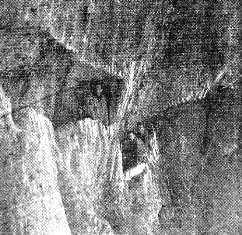 Hewn from the solid rock, tunnels connect various parts of the Buddhist establishment sprawling over the mountain's
face.
Hewn from the solid rock, tunnels connect various parts of the Buddhist establishment sprawling over the mountain's
face.
|
The visitors were on the east slope, so the sun was hidden from view. Climbing steadily, they came to the vaulted gate of the first temple.
On either side of the foyer was a pair of giant, multi-colored clay statues. Tableaux of ancient wild life were painted on their flowing gowns.
A novice in a long, dull-grey robe collected offerings from worshippers as they entered the temple, inscribing their names on a scroll and handing each a bundle of joss sticks.
Facing the door, on the main altar, was a trinity of colossal images of Buddha, each with a pearl as large as a golf ball on its forehead and a fylfot, or "left-handed" swastika on its chest. The space along the side walls was peopled with scores of statues, some grotesque in appearance and others looking more amiable.
Camera Heaven
Magnificent brocaded tapestries hung from the ceiling. Several elaborately carved gongs and tongueless bells were suspended with cords. The mystic aura enveloping the place was enhanced by the fragrance of incense and burning joss sticks. Novices reciting the sutas accompanied their chant with a dull, hollow tattoo from wooden temple blocks. Here was a camera enthusiast's heaven, and GIs ciceroned by American Red Cross girls or pretty Chinese girls were making the most of the occasion.
The reluctant, wheezing weapons carrier took the travelers up another steep grade to temple number two. Older and less ornate than the first, its severe classic simplicity matched the serene quiet of the gardens, broken only by hushed voices of sightseers and the gurgle of a spring. The air, nippy and damp, was sweetened by the fragrance of camellias in bloom
The view from the roomy, balustraded terrace on the temple's top level was breathtaking. The lake below shimmered in the bluish haze that blanketed the landscape. The only suggestion of human life was the myriad sails of sampans skimming lazily over the water.
The third temple was inaccessible by truck. Gasping for breath, the tourists plodded wearily up hundreds of narrow stone steps, worn smooth by the feet of pilgrims. To the left, a gaping chasm; to the right, a perpendicular, craggy cliff. Miraculously, this man-made temple lashed by the fury of the elements, clung to the mountain wall. Weather-blackened balustrades, over-hanging the great void, rattled ominously. Still one felt strangely secure. The temple seemed rooted in the mountain, as solid and indestructible as the rocks protruding from its shaggy slopes.
Two thousand years were embedded in those glossy steps, the tattered figures, hieroglyphs on the walls. It was like gazing on the excavated remains of a remote, defunct civilization. yet Buddhism is far from dead. It's still a vital factor in the lives of a large part of the earth's population. This fact was forcefully brought home by the sight of an old bald, clean-shaven bonze standing motionless in the garden insensible to the milling crowds, with eyes fixed in fierce contemplation on an altar panel on which rested a single miniature image of Buddha.
A strange silence had settled over the little party as it descended to the level of the lake, where the weapons carrier was waiting to go back to the base.
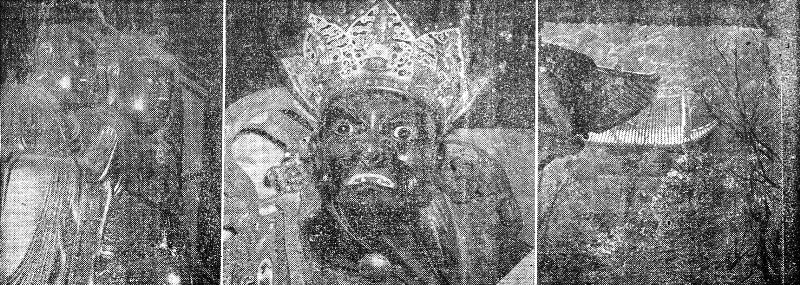
These pictures show the first C-54 flight from the new 1346 BU, activated on Mar. 1. Left: Three attractive Chinese girls came down to the flight line to see the boys off on the first Hump flight. Here Sgt. Ed Crump, Pittsburgh, Pa., (left)

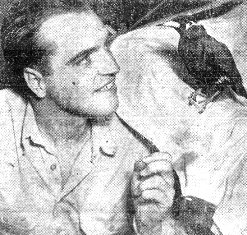 Pvt. Julien Bronson, New York City, is the owner of Lucille, named after his girlfriend. Lucille, the bird,
can talk almost as much as Lucille, the woman. Bronson has been in India nearly two years and teaching Lucille
to talk was one of his major accomplishments - until Lucille picked up some profanity which now has him worried.
Pvt. Julien Bronson, New York City, is the owner of Lucille, named after his girlfriend. Lucille, the bird,
can talk almost as much as Lucille, the woman. Bronson has been in India nearly two years and teaching Lucille
to talk was one of his major accomplishments - until Lucille picked up some profanity which now has him worried.
|
Lucille's Language Shame
in Indian or Brooklynese
1333 BU, Assam - "I tell ya de boid talks!"
"How long have you been in Assam, pal?"
"Come on and take a look!"
So the twosome visited the tent of Pvt. Julien Bronson, switchboard operator here, to find out who was crazy. The accused asked Bronson if he could see his pet bird, Lucille.
Lucille was perched on the roof of the tent with her head cocked as she studied the visitors. "Hello ..."
The accuser eyed Bronson with suspicion. "How long you been a ventriloquist, Bud?"
Pvt. Bronson, prepared for situations like this, displayed a clothbound book published by the Bombay Natural History Society entitled, "The Book of Indian Birds," and turned to the chapter on Hill Mynas. It read:
"The Hill Myna, inhabitant of the foothills of the Himalaya mountains, has exceptional value as a cage bird. They (Mynas) are mimics of exceptional merit, become very tame, and soon learn to reproduce the human voice and speech with astonishing clarity."
Lucille's owner has a keen knowledge of feathered friends after a ten-year study back in New York City, where he raised finches, canaries, parakeets and others. His hobby was interrupted when he entered the service two and a half years ago, but he soon learned that the birds of India were far more enchanting than the common species found in the States. While Bronson was explaining the characteristics of Lucille, the bird began rattling off words with a half Hindustani-half Brooklyn accent.
Pvt. Bronson keeps Lucille in a cage outside his tent. Her wings are clipped, so she cannot fly away, but the cage is necessary to protect her.
"There's no controlling that mouth of hers anymore," Bronson murmured with a worried expression. "Whenever an officer makes an inspection of tents, I keep my fingers crossed, hoping that Lucille doesn't say anything for which we'd both be sorry."
|
RECONVERSION
When bugles sound their final notes And bombs explode no more. When we return to what we did Before we went to war. The sudden shift in status On the ladder of success Might make some worthy gentlemen Feel like an awful mess. Just think of some poor captain, Minus his silver bars, Standing behind a counter Selling peanuts and cigars. And think of all the majors With their oak leaves far behind, And the uniforms they're wearing Are the Western Union kind. Shed a tear for some poor colonel If he isn't quite himself; Jerking sodas isn't easy With your eagles on a shelf. 'Tis a bitter pill to swallow, 'Tis a matter of despair. Being messenger and clerk again's A mighty cross to bear. So be kind to working people That you meet where e'er you go, For the guy that's washing dishes May be your old CO. - Camp Siebert News |
 "You're sure it's a monkey ?"
"You're sure it's a monkey ?"
|
38 Percent Cut
In Rubber Use
At Assam Base
Intensive Campaign Pays
Handsome Dividends at 1330
1330 BU, Assam - Showing a 38.6 percent savings since November, the rubber conservation program is bearing down harder than ever at this base, according to Capt. Ronald R. Johnson, Robersonville, N.C., unit rubber coordinator.
An intensive advertising and educational campaign is paying off, he said. Comical cartoons are spotted at various strategic points like gas stations, maintenance shops, motor pools and parking lots, urging in a humorous vein that better care be taken of tires. Radio skits are broadcast at the local ICD station daily.
Often a tire which has been ruined through carelessness is rolled on the stage at the theater and some member of the rubber coordinator's staff explains how this waste could have been spared.
Tire repairers are being sent to the rubber conservation school in Calcutta, and four have returned to help teach the others in their section.
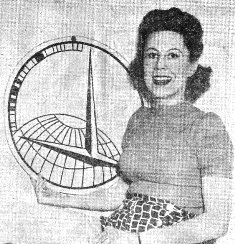 In line with the "home-grown cheesecake" which has been circulated so much lately - and found so delectable - here is
Babs Hamilton, Kunming Red Crosser, who we think compares quite favorably with the best. She is billed as "the
sweetheart of the China wing."
In line with the "home-grown cheesecake" which has been circulated so much lately - and found so delectable - here is
Babs Hamilton, Kunming Red Crosser, who we think compares quite favorably with the best. She is billed as "the
sweetheart of the China wing."
|
Pair of Pilots Claim Record on Final Approach
11,000 Feet Above Field Pilot Started Descent To Runway
1330 BU, Assam - A couple of pilots here would like to know whether anybody has ever landed a four-engine transport in a higher final approach than they did recently.
The landing, necessitated by trouble with engine No. 4 was begun at 16,000 feet indicated -altitude and was made on a 5,000-foot high field.
When No. 4 cut out, Lt. B. S. Gibson, of Waycross, Ga., first pilot, ordered the prop feathered, but there was no answering response to the feathering button and No. 4 continued to windmill, causing much vibration. Finally the engine froze. Owing to the drag, altitude could not be maintained.
Casting about for a place to sit down, Gibson located the small, mile-high auxiliary field, with a mountain just off the runway. It looked poor, but it was all there was.
He circled the field and after a 45-second base leg ended up on the final approach at 16,000 feet. Calling to Lt. O. E. Scott, of Odessa, Tex., co-pilot, for "gear down, full flaps, power off and anchor out," he began the 11,000-foot descent, for it was obvious that the ship would never go around the field again.
Just before leveling out, Gibson called for ten inches of manifold pressure to break the descent, and Scott put the power on the two inboard engines. The landing was three-point.
Takes Supplies to Hillfolk in Appreciation for Help
1333 BU, Assam - Cpl. Leslie Lindgard of this base has just been granted 25 days' detached service as a result of the most unusual request ever received by the orders section.
An aerial engineer from Seattle, Wash., Cpl. Lindgard requested time off to lead a party into the jungles of North Burma to deliver a load of supplies to a family of hillfolk, in appreciation for aid rendered when the engineer and his crew were lost in the hills after abandoning their stricken plane.
Cpl. Lindgard is the only remaining member of the crew of three who had been clothed, fed and guided out of the jungle to safety. The pilot of the plane since has been killed in a crash and the radio operator went back to the U.S.
Contributions for purchasing the merchandise, which will go to the friendly family, were made by the men of a squadron here. The gifts include 193 yards of cloth, 150 pounds of salt and 200 pounds of native rice.
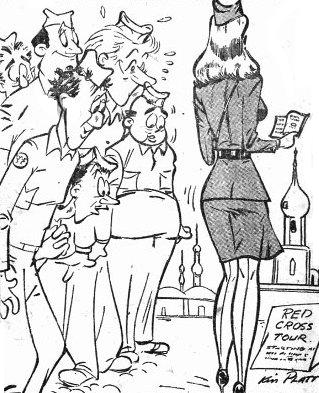 "... and on your left, the rarest and most interesting sight in India ..."
"... and on your left, the rarest and most interesting sight in India ..."
|
Has His Own Ideas On Jungle Kit Items
1332 BU, Assam - One time Hump bail-out Pfc. Joe Ballas, New York state, has added something new to his jungle parachute kit.
When Joe, who is a crew member radio operator, landed on the "rock pile" after parachuting from his disabled Commando in January, he lived for days on the scanty life-sustaining provisions in his emergency kit, attached to every parachute used on the Hump run.
Now, when Joe goes on a trip, he carries another kit of his own manufacture - a musette bag containing such comforts as toothpaste, comb, handkerchief, reading material, salt and pepper, and a roll of toilet paper.
Fight Anopheles' Crimes With Roadside Signs
1333 BU, Assam - The Burma Shave jingle signs, familiar to motorists in the States, have found their counterpart at this ICD base.
Individual signs, each carrying two or three words, and spaced on trees 25 yards apart, tell of the mosquito danger in a humorous way to passing drivers and their passengers.
One read-as-you-ride jingle says:
"If you want . . . to stay healthy . . . and feeling fine . . . use repellent . . . at specified time . . . Malaria Control."
HUMP EXPRESS is the official newspaper of the India-China Division, Air Transport Command, APO 192, c/o Postmaster, New York, N.Y., and is published by its Public Relations office. Camp Newspaper Service and Army Newspaper Service features are used, reproduction of which is prohibited without permission of CNS and ANS, 205 East 42nd St., New York, 17, N.Y. Other material is submitted by staff members, ICD-ATC base Public Relations sections and other soldier correspondents. Printed weekly by the Hindusthan Standard, 3 Burman St., Calcutta, India, and distributed each Thursday. Passed by U.S. Press Censor for mailing.
| Military transport schedules over India for cargo, personnel and mail . . . maximum tonnage of essential war materials over the Hump . . . movement of troops and supplies in support of tactical operations in China . . . evacuation of the sick and wounded - these are the missions of ICD-ATC. |

MARCH 15, 1945
Original issue of HUMP EXPRESS shared by CBI veteran Steven C. King, author of Flying the Hump to China.
Copyright © 2006 Carl Warren Weidenburner
TOP OF PAGE PRINT THIS PAGE ABOUT THIS PAGE E-MAIL YOUR COMMENTS
PREVIOUS ISSUE HUMP EXPRESS BASE NEXT ISSUE
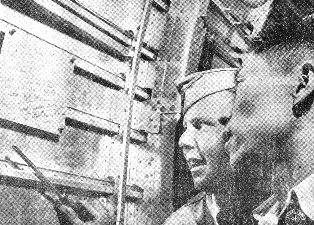 Sgt. Sammy C. Boyd, Washington, D.C., and a student of the mechanic school for members of the Chinese Air Corps
look at an inscription giving the history of the oldest Hump-flying C-87, with 250 missions to its credit, brought to
the Hindustan Aircraft factory, Bangalore, for heavy overhaul. The inscription gives the name of an interested
party in Assam, and continues, "Let me know about this bag of bolts when it hits the States - if it does."
Sgt. Sammy C. Boyd, Washington, D.C., and a student of the mechanic school for members of the Chinese Air Corps
look at an inscription giving the history of the oldest Hump-flying C-87, with 250 missions to its credit, brought to
the Hindustan Aircraft factory, Bangalore, for heavy overhaul. The inscription gives the name of an interested
party in Assam, and continues, "Let me know about this bag of bolts when it hits the States - if it does."